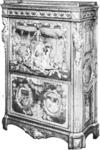- ormolu
-
/awr"meuh looh'/, n.2. Also called bronze doré, gilt bronze. gilded metal, esp. cast brass or bronze gilded over fire with an amalgam of gold and mercury, used for furniture mounts and ornamental objects.3. gold or gold powder prepared for use in gilding.[1755-65; < F or moulu ground gold, equiv. to or ( < L aurum) + moulu, ptp. of moudre to grind < L molere]
* * *
(from French dorure d'or moulu, "gilding with gold paste") Gold-coloured alloy made up of copper, zinc, and sometimes tin in various proportions but usually at least 50% copper.It is used in mounts (ornaments on borders, edges, and as angle guards) for furniture and for other decorative purposes. After the molten alloy has been poured into a mold and allowed to cool, it is gilded with powdered gold mixed with mercury. It is then fired at a temperature that evaporates the mercury, leaving a gold surface. Ormolu was first produced in France in the mid-17th century, and France remained its main centre of production. Secretary decorated with ormolu mounts, marquetry, and intarsia, French, c. 1770; in the Wallace ...By courtesy of trustees of the Wallace Collection, London
Secretary decorated with ormolu mounts, marquetry, and intarsia, French, c. 1770; in the Wallace ...By courtesy of trustees of the Wallace Collection, London* * *
(from French dorure d'or moulu: “gilding with gold paste”), gold-coloured alloy of copper, zinc, and sometimes tin, in various proportions but usually containing at least 50 percent copper. Ormolu is used in mounts (ornaments on borders, edges, and as angle guards) for furniture, especially 18th-century furniture, and for other decorative (decorative art) purposes. Its gold colour may be heightened by immersion in dilute sulfuric acid or by burnishing.The earliest ormolu appears to have been produced in France in the mid-17th century, and France always remained the main centre of manufacture, though fine examples were also produced in other countries during the 18th and 19th centuries. To fashion ormolu, a model is made in wood, wax, or some other suitable medium; a mold is formed and the molten alloy is poured into it. The cast alloy is then chased (ornamented with indentations) and gilded. True ormolu is gilded by a process whereby powdered gold is mixed with mercury, and the resulting paste is brushed onto the cast form. The whole is then fired at a temperature that causes the mercury to evaporate, leaving a gold deposit on the surface. Finally, the gold is burnished or matted to give the greatest effect of metallic brilliance. (During the second half of the 19th century, pieces were gilded by a process of electrolysis, and these are often inaccurately referred to as ormolu.) Master craftsmen who worked in ormolu include Jean-Jacques Caffieri, Pierre Gouthière, and Pierre-Philippe Thomire in France and Matthew Boulton in England.* * *
Universalium. 2010.
